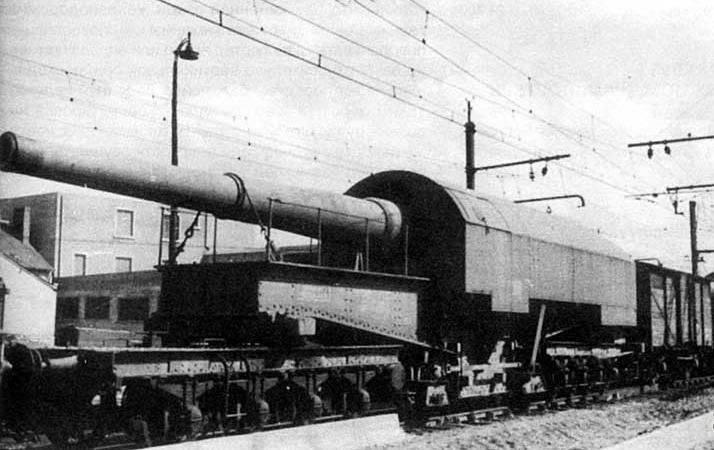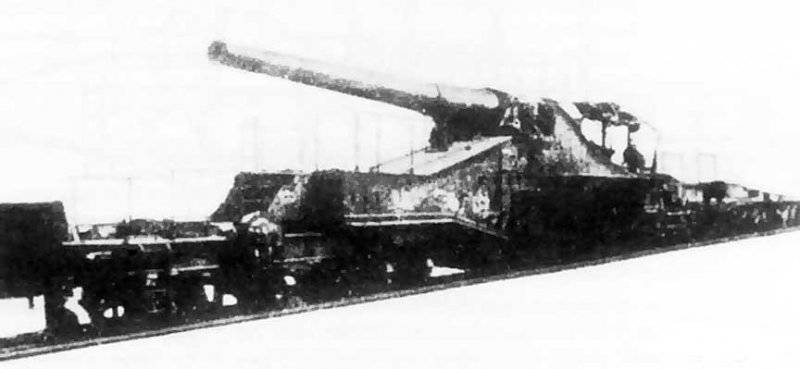The guns on the railway transporter. French 274-mm cannons M 1887 / 93 and M 1893 / 96
For firing from this gun used high-explosive shells weighing 261 kg, stored in large quantities in French warehouses fleet. The powder charge (weight 63,65 kg) was divided into two half-charges. The firing range of such shells, at an initial speed of 740 meters per second, was 24,4 km. At the end of the war, a high-explosive projectile with a M 1917 ballistic tip was also developed for the cannon. The mass of this projectile was 237,5 kg, and the initial speed was 785 m / s.
The conveyor designed for the gun at the same time was its carriage. The carriage had a bulky main beam, which consisted of steel longitudinal beams, fastened with cross links. The main beam was installed on two railway carts with five axles. The transporter of horizontal-guidance mechanisms did not have, the gun had a rigid attachment, which excluded the possibility of making amendments in the horizontal plane. The mechanisms of vertical guidance - manual. The design of the mast allowed the vertical aiming of the gun in the range of + 25 .. + 40 degrees. Before the start of the fire, special beams were laid on the rails, on which, with the help of screw jacks mounted on a conveyor belt, six pillars were lowered, which were transverse wooden bars that were iron-bound. Supports perceived the bulk of the mass of the conveyor. All work on the translation of the installation in the combat position of the marching took about 30 minutes. The supports after the shot slid along the beams laid on the rails, and the recoil energy was extinguished due to the friction force. However, after the shot, the installation rolled back about a meter, therefore, to return it to its original position, special hand-guided mechanisms were installed on the conveyor.
Due to the huge dynamic loads that occurred during the shot, the cellar car could not be permanently attached to the conveyor. Therefore, they equipped an intermediate cellar loaded from a cellar car using a roller table and a crane. The shells from the intermediate cellar were supplied to the gun with the aid of a shell cart, half-charges were brought manually.
Schneider used a conveyor for the 274-mm 1887 / 93 M gun to build an artillery train with the 274-mm 1893 / 96 M gun. The guns of this model were removed from the outdated battleship Henri IV. The length of the gun was 41,9 caliber, threaded part - 29,85 caliber, mass 35,4 t.
On the conveyor, the gun was mounted on its standard machine with a cradle. Also used "native" recoil devices. The conveyor was similar to the "sliding type" transporters. A distinctive feature of this tool was that the rear mounted railway carriage was equipped with a mechanism that allowed the conveyor to be rotated to the right or left approximately 1 degrees relative to the vertical axis (middle of the front carriage balance bar). The use of this mechanism provided an adjustment of the horizontal pickup of the gun. The main aiming in this plane was carried out as in all railway installations of a “sliding type”, that is, by moving the installation along branches of a railway track.
Since the standard machine gun was used, the maximum elevation angle was + 25 degrees. This reflected negatively on the firing range: instead of 24,4 km, the range of high-explosive shells with a mass of 261 kg was 21 km. At the same time, thanks to the cradle on the machine and powerful recoil device, the conveyor was exposed to only a small part of the recoil energy, which reduced the weight of the conveyor and the entire artillery train to 116 tons, and also significantly simplified its preparation for firing. It was only necessary to strengthen the rails with longitudinal specials. overlays, and then with the help of screw jacks, lower two transverse supports onto them. Rail clamps were also used to quench the recoil energy. It took about 2 hours to prepare the installation for shooting.

It is noteworthy that due to the use of machine recoil devices and friction on the rails of the support bars, the recoil energy was extinguished so much that after each shot the installation was shifted back only by 40. / 274 with the help of winches was carried out after 1893 — 96 shots. The peculiarity of this railway installation was also the fact that the intermediate cellar, the workplaces of the payroll numbers and all the other mechanisms of the gun were closed with a solid armor cover. It began to install after the German aircraft began firing machine guns French installation. Such attacks led to significant losses among the calculations of artillery installations.
Since the survivability of the barrels of both guns was equal to 500 shots, they were subsequently drilled down to 285 mm, and the rail guns armed with them were given the designation 285-mm gun 17. Sometimes the wings were reamed even to the caliber of 288 millimeters. Schneider 274-mm guns on the railway conveyors produced in series. The French army to the beginning of the Second World War was armed 16 such installations. In the 1940 year they were captured by the Germans and under the designation 28,5, see K. (E) 605 (f) were used by them on the Western Front.
Performance characteristics of the M 1887 / 93 and M 1893 / 96:
Caliber - 274,4 mm / 274 mm;
Barrel length - 46,7 gauges / 41,9 gauges;
The largest elevation angle is + 40 deg / + 25 hail;
Angle of horizontal fire - 0 deg / 2 hail;
Weight in the fighting position - 152000 kg / 116000 kg;
The mass of the high-explosive projectile - 261 kg;
The initial velocity of the projectile - 740 m / s / 800 m / s;
The greatest range of shooting - 24400 m / 21000 m.
- The guns on the railway transporter. French 155 mm 1877 M
The guns on the railway transporter. French 164-mm cannons M 1893, M 1893 / 96 and M 1893 / 96 M
The guns on the railway transporter. French 274-mm cannons M 1887 / 93 and M 1893 / 96
The guns on the railway transporter. French 240 mm 1884 / 17 M
The guns on the railway transporter. French 305-mm cannons M 1893 / 96, M 1906 and M 1906 / 10
The guns on the railway transporter. French 194 mm cannon 1870 / 93
The guns on the railway transporter. French 340-mm cannons M 1881, M 1884, M 1893 and M 1912
The guns on the railway transporter. French 340-mm gun 1912 M on the "carriage with a cradle"

Information